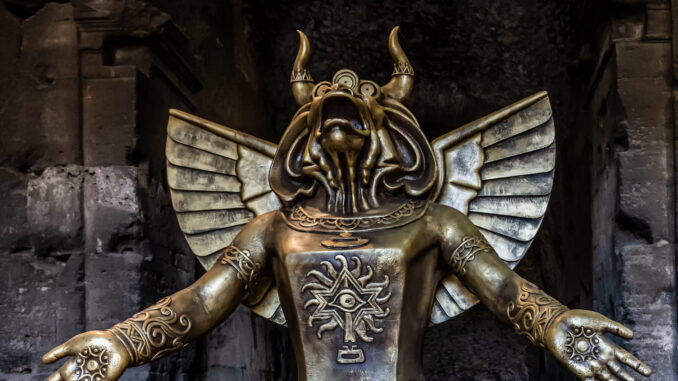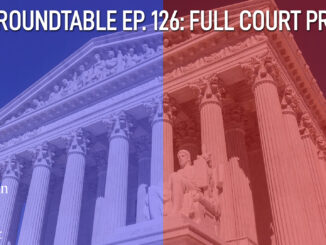
Pro-abortion reactions to the Dobbs leak reveal idolatry for what it is.
<p class="has-drop-cap">The pro-abortion response to Samuel Alito’s leaked draft majority opinion overturning Roe v. Wade and Planned Parenthood v. Casey has been visceral. Protesters and mobs <a href="https://www.ncregister.com/cna/updates-on-mother-s-day-threats-new-incidents-reported">disrupted church services</a>, <a href="https://www.ncregister.com/cna/police-wisconsin-pro-life-group-s-headquarters-set-ablaze-in-apparent-arson-attack">vandalized pregnancy resource centers</a>, and <a href="https://www.cnn.com/videos/politics/2022/05/08/abortion-protests-supreme-court-houses-maryland-brett-kavanaugh-john-roberts-orig-kj.cnn/video/playlists/top-news-videos/">swarmed outside of Supreme Court Justices’ homes</a>. This behavior, which received both express and tacit approval from powerful progressive institutions and voices, may only be a preview of what we should expect during the <a href="https://www.womensmarch.com/initiatives/summer-of-rage">“Summer of Rage”</a> if indeed those cases are overturned.</p>
If the leak and potential decision are surprising, the pro-abortion reaction should not be. It becomes perfectly predictable when one understands abortion, not as a secular institution, but as an institution of religious idolatry. When prominent officials proclaim that the right to abortion is “sacred” and many women righteously (and, sometimes, mournfully) shout their abortions, they are channeling the sort of religious rhetoric Naomi Wolf called for pro-choicers to adopt a generation ago in The New Republic (“Our Bodies, Our Souls”): to admit that abortion takes human life, but to co-opt the “matrix of the sacred” and moralistically frame abortion as a necessary “sacrifice.” Rather than reiterate the pro-life case, then, my aim here is to show how pro-abortion rhetoric and behavior is best understood and accounted for in religious terms, as the worship of a false god.
The Factory of Idols
St. John Paul II said that man is “constantly tempted” to idolatry. Indeed, the former pontiff suggested that idolatry is the primary manifestation of the very essence of sin, the rejection of God. This is not an arcane point of dogma but a powerful description of the human condition: as St. Paul explained in his letter to the Romans, idolatry is the exchange of the truth of God for a lie to worship and serve the creature rather than the Creator. “Ye shall be as gods,” said the serpent. The temptation of Adam and Eve was to idolize the Self.
It is therefore a mistake to identify idolatry merely with the worship of graven images or pagan deities, such as Ba’al or the golden calf. Idolatry is making anything other than God into one’s highest good. Money, power, fame, pleasure, liberty, man himself, the state, and even an ideology can be idolized. Though some of these things are good in themselves, they become evil taskmasters if all other goods are made subordinate to them.
Indeed, Thomas Aquinas demonstrated that no earthly object could sate the soul’s deepest appetite, which can only be finally answered by the universal good, that is, God Himself. Absent genuine religion, the universal desire for fulfilment restlessly seeks objects in which to rest. In St. Thomas’s words: “Hence of gluttons it is written (Philippians 3:19): “Whose god is their belly”: viz. because they place their last end in the pleasures of the belly.”
Paul Tillich made a similar point when he defined “faith” in the inclusive sense as “ultimate concern.” Since every person has an ultimate concern, every human being participates, knowingly or unknowingly, in some form of religion. It is thus one of the great conceits of our age when secularists (at least when it suits them) pigeonhole “religion” as institutional expressions of traditional faiths, and contrast their own secular faith with these older rituals as pure reason. Everyone, without exception, seeks some highest good. The ferocity and anguish with which pro-abortion activists reacted to the Dobbs leak revealed that overturning Roe would cut close to what they consider the highest good. But what is that highest good—who is the pro-abortion movement’s idol?
“Liberation”
As the god of the gluttons is in their bellies, so it would not be too far off the mark to say that the god of many late modern individuals is in their genitals: they place their last end in the pleasures of the bed, and orient their lives toward maximizing those pleasures. Another way to put this is that late modern man has set up sexual satisfaction as his idol.
Carl Trueman’s recent intellectual pedigree of the modern self calls our attention to some of the key figures who helped install sexual pleasure as our modern idol (my term). Marx and Darwin radicalized Rousseau’s suggestion that human nature is not fixed but plastic, a byproduct of economic forces and natural selection. Nietzsche attacked Christian metaphysics as the “theologian instinct,” which he contended was the tendency to mistake one’s personal desires as the will of the Most High.
If classical Christian metaphysics is mere prejudice and superstition, and if man is infinitely moldable, then “autonomy” comes to mean self-creation through conquest of the body. Sigmund Freud carried forward the spirit of these attacks on classical Christian metaphysics by interpreting worship—and a great deal of other human behavior—not as true teachings about reality but as oblique expressions or outgrowths of primitive sexual and appetitive impulses. For Freud, man may usefully repress and sublimate his sexuality, but he remains sexual at his core. Many of his disciples came to think of metaphysical beliefs as superficial obfuscations disguising an essential, sexual core.
The New Left warped and politicized Freud’s ideas, using them to analyze mankind as a sexual animal. Echoing the spirit of Michael Walsh’s arguments, Trueman emphasizes the influence of members of the Frankfurt school like Wilhelm Reich and Herbert Marcuse, who wed Freud to Marx, arguing that traditional sexual mores and codes were constructed by power groups to perpetuate their own class interests. So, for example, the norm against teenage sex and masturbation was really a patriarchal repression of the child’s instinct, to fit him for membership in an authoritarian social order. The nuclear family was thus a miniature authoritarian state. Sexual liberation became the prerequisite of political liberation for the New Left.
The American legal tradition, metaphysically grounded in classical, Christian theism and natural law, was fairly resilient through the 19th and into the early 20th century to the radical strands of Enlightenment thought and their heirs. While one could find examples of sexually liberated lifestyles and communities, e.g., among the American Bohemians, these were relatively fringe social phenomena. Indeed, as late as the New Deal, social welfare institutions assumed the normativity of the traditional nuclear family.
The institutional watershed came in Griswold v. Connecticut (1965), which legalized the purchase of contraceptives by married couples. As I have argued elsewhere, this case represented a new tack of the Court, to enunciate a natural law jurisprudence without nature. Justice William Douglas’s grandiose language about the sanctity of privacy and marriage was reminiscent of the older first-principles style of reasoning one sometimes encountered in American courts, except that liberty was detached from any prior teleological order of being. His slights toward “political faiths” and “commercial and social projects” were not-so-thinly veiled attacks on the procreative telos of marriage that had long been sanctioned in American law and promoted by various institutions of civil society.
For most of history, marriage had contained and channeled sexual desire toward real human goods like children, friendship, authentic religion, and the virtues necessary for ordered family life. In such an order, erotic desire was a conditional good, to be subordinated and sublimated for the sake of higher loves and goods when fitting. Though reasonable minds may differ about the existence and extent of a right to privacy in the Constitution, the logic of Griswold fundamentally implied that marriage was no longer essentially marked by permanence and procreation. Then, in Eisenstadt v. Baird, the Court extended Griswold’s logic to unmarried individuals. Bolstered by the technological mastery over the body that contraception offered, it was now possible to obtain sexual gratification without embracing the social roles and responsibilities of marriage or parenthood. Roe and Casey were built on the foundational logic of these cases.
What John Paul II called “structures of sin” are institutions that teach and encourage evil, and the pope explicitly connected such structures with idolatry. The abortion jurisprudential regime in American constitutional law is such a structure. Sexual gratification had become institutionalized as a highest good—a hidden god of physical desire and its fulfillment. And once enthroned, the god demanded sacrifice.
Blood on the Altar
Sacrifice is the central act of religion. It consists in giving up of some good for the sake of a higher good, one’s final end. Widespread contraception meant sacrificing fertility and potential parenthood in order to maximize sexual pleasure. But this new idol, it turned out, was both fickle and insatiable. To truly rule over American society, he demanded total control over childbearing, even in cases where contraceptives failed. And that required abortion.
Of course, human beings have sacrificed their children to idols before. One can think of Huitzilopochtli, the Aztec war god or the Canaanite god of fertility and harvest, Ba’al. But these sacrifices did not have the worship of sexual pleasure as their objects. The abortion license in our time is distinct in that it is an institutionalized offer to the idol of sexual satisfaction.
Since this idol demanded the sacrifice of the goods of actual parenthood and children, Roe v. Wade became necessary to complete what Griswold started: the full legal sanction of sexual idolatry and therefore blood sacrifice to the god. Peter Kreeft memorably argued that the pro-abortion mantra “it is my body” is a demonic mock-imitation of Christ’s words at the Last Supper and the Eucharistic prayer. Abortion, understood as a false sacrament, reveals itself as a sacrifice on the altar of sexual satisfaction.
To be clear, I am not claiming that every single instance of abortion is formally an act of erotic idolatry in the mind of the woman. What makes this nationwide idolatry so pernicious is that it does not depend on personal assent to worship a false god. Individual women choose to have abortions for all sorts of reasons—to escape financial strain or shame, to maximize career success, or to avoid the physical stress of pregnancy. But the culture in which women make those choices is informed by an idolatrous logic—the logic that would prioritize sexual freedom over the life of a child. This logic is apparent so-called “moral hazard effect” that accompanies easy abortion access: increased sexual activity and less contraceptive use, and therefore, more abortion. A culture that frames abortion—rather than adoption or abstinence—as an acceptable mode of engaging in sex without the risks and consequences of childbirth, is a culture that runs on the logic of erotic idolatry.
Structures of sin can take on a sort of life of their own and generate other sins, even impairing the sense of sin in the conscience. One sign of this is the distortive effect institutionalized abortion has had on the consciences not only of elites, but of the women who are at once participants and victims of the abortion industry. This is apparent in the warped reasoning about fertility regulation.
The utilitarian reasons given for abortion—financial worries, timing, relationship problems—could, in the abstract, be good reasons in a well-formed conscience for, say, child spacing through abstention. But they prompt many modern women to seek abortions, because of the environmental logic which discourages subordinating sexual satisfaction to anything else. This is why understanding sexual satisfaction as a false god or a demon helps give a truer account of things: he has a logic and goals of his own, which his subjects need not accept in order to obey.
The Hidden God
One might object that my thesis is unwarranted by any actual evidence in the Court’s abortion opinions. After all, why shouldn’t we take the Court at its word, that the justices were simply trying to protect the right of women to control their own destiny and participate as equals in our society? But here, again, thinking in terms of idolatry makes more sense of the evidence. Once one understands that sexual pleasure is the deus absconditus, the hidden god, in between the lines of the Court’s abortion jurisprudence, the actual meaning of the Court’s language of liberty and equality is unveiled.
Consider the infamous claim in Casey that the heart of liberty is the right to define one’s own concept of existence. This did not mean that the idolized Self has the legal right to set up any idol. If the ATF catches you making moonshine for sacrifice to Bacchus, the Constitution will provide little refuge, and so on with all sorts of behaviors that remained criminalized after Casey. Rather, the Self was empowered to make this specific sacrifice, the sacrament of abortion. If one were really free to define existence, one would have the right to do absolutely anything at all. But the real object here is only one kind of license: the license to seek sexual pleasure at the cost of nascent human life.
Perhaps the biggest clue as to the identity of the hidden god of Casey came in the Court’s inquiry into whether overruling Roe would violate “reliance interests.” Some argued that overruling Roe would not amount to an inequitable burden on women, since “reproductive planning” could immediately take into account the legal status of abortion in one’s state. The Court replied that, in the twenty years following Roe, abortion had become customarily chosen as a response to contraceptive failure. It had become central to how “people have organized intimate relationships” and to their “choices that define their views of themselves and their places in society” precisely because contraception might “fail.”
True, the Court also gave a distinct egalitarian reason to uphold Roe, that abortion facilitated women’s social and economic equality. But equality was at best a subordinate idol, a demigod as it were—and a glittery one at that. As Erika Bachiochi has argued, the equality contention was in fact hollow for a number of reasons, not least of which is that there was no evidence demonstrating that abortion, as distinct from other forms of regulation of fertility, correlated with greater workplace and education participation and achievement. Abortion had become enshrined as the necessary way of dealing with unplanned pregnancies, because all other modes involved curtailing sexual freedom.
Once one understands that sexual satisfaction is the god enthroned by our abortion jurisprudence, and therefore in the hearts of the pro-abortion faithful, the visceral paroxysms following the draft opinion of the Dobbs case are revealed for what they truly are. The fear, sorrow, and rage are outbursts of religious feeling. No doubt the emotions are genuinely felt. That does not change the fact that the clearest and simplest account of them is as the response of offended worshipers whose god suffers an indignity or threatens to fall from his throne.
Augustine, in assessing Scipio’s definition of a republic as the good of a people united by common acknowledgement of right, came to the troubling conclusion that Rome never was a true republic, since that would imply its worship of demons was just and good. Augustine can be read as carrying forward David’s insight in the Psalm that “all the gods of the peoples are idols.” A people, Augustine argues, are united by the common objects of their love. And unless that love is the one true God, it will be a form of idolatry and therefore devoid of true justice. The abortion debate is so visceral because it is fundamentally about what and whom will be the common object of our love.
The confident secularists of the Enlightenment failed to see that, when the temple is swept clean of the traditional Judeo-Christian dogmas, demons will rush in to take their place. It turns out that, when citizens believe in a god who demands human sacrifice, Jeffersonian toleration has found its limit. Returning abortion policy to the states will at least allow citizens to take modest measures to exorcise the demon by starving him. Such efforts to restrict abortion, too, could be seen as “religious” acts in the broadest sense of that term. In that sense, every polity worships something. It’s just a question of what.
Apareció primero en Leer en American Mind






Be the first to comment